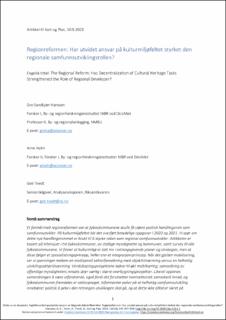| dc.description.abstract | Et formål med regionreformen var at fylkeskommunene skulle få større politisk handlingsrom som samfunnsutvikler. På kulturmiljøfeltet ble det overført betydelige oppgaver i 2020 og 2021. Vi spør om dette nye handlingsrommet er brukt til å styrke rollen som regional samfunnsutvikler. Artikkelen er basert på intervjuer i tre fylkeskommuner, av statlige myndigheter og kommuner, samt survey til alle fylkeskommunene. Vi finner at kulturmiljø er tatt inn i retningsgivende planer og strategier, men at disse følger et spesialiseringsprinsipp, heller enn et integrasjonsprinsipp. Når det gjelder mobilisering, ser vi spenninger mellom en tradisjonell sektorforvaltning med objekttilnærming versus en helhetlig utviklingsaktørtilnærming. Verdiskapingsprosjektene bidrar til økt mobilisering; samordning av offentlige myndigheters innsats skjer særlig i større overbygningsprosjekter. Likevel oppleves samordningen å være utfordrende, også fordi det forutsetter tverrsektorielt samarbeid innad, og fylkeskommunen fremdeles er sektorpreget. Informanter peker på at helhetlig samfunnsutvikling innebærer politisk å peke i den retningen utviklingen skal gå, og at dette ikke alltid er sikret på kulturmiljøfeltet. Studien viser at prosjektene, særlig overbygningsprosjektene, har en samordnende funksjon – og bidrar til å øke den samlede mobiliseringskraften. De muliggjør koordinert ressurs- og virkemiddelbruk og dermed synergier mellom aktørene.
One purpose of the regional reform was that the county councils would increase their political scope as community developers. In the field of cultural heritage, significant tasks were transferred to county councils in 2020 and 2021. Based on interviews in three county municipalities, of state authorities and municipalities, as well as a survey of the county municipalities, the article asks if this new scope is being used to strengthen the role. We find that cultural heritage concerns are included to a greater extent in plans and strategies, but that these follow a specialization principle rather than an integration principle. When it comes to mobilization, we see clear tensions between a traditional conservationist attitude versus a holistic development actor approach. The county municipalities are particularly successful in coordinating the public authorities’ efforts in large umbrella projects. Nevertheless, the coordination is perceived to be challenging, also because it requires internal cross-sectoral cooperation, and the county municipalities are still divided into sectors. Informants point out that holistic social development involves stronger political direction, and that this is not always ensured in cultural heritage questions. The projects, especially the ones being characterized having umbrella functions, are considered to have coordinating and mobilizing effects. | en_US |

